Introduction
In the fiercely competitive landscape of eCommerce, achieving success is not solely about driving traffic to your online store; it is also about converting that traffic into satisfied customers. Conversion Rate Optimization (CRO) is the key to unlocking the full potential of your eCommerce business. In this comprehensive guide, we will delve into the best practices, recommendations, and strategies that can significantly enhance your conversion rates and boost your online revenue.
Understanding Conversion Rate Optimization
Conversion Rate Optimization (CRO) is the systematic process of improving the percentage of website visitors who take the desired action, whether it is making a purchase, filling out a form, or subscribing to a newsletter. To achieve optimal results, it is crucial to implement CRO best practices, which encompass a combination of data analysis, user experience enhancement, and strategic testing.
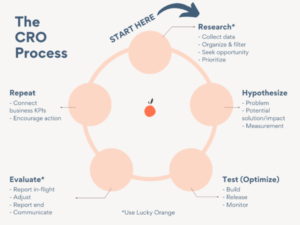
Source: Lucky Orange
Conversion Rate Optimization Tactics and Strategies for eCommerce
The best practices of Conversion Rate Optimization (CRO) encompass a set of strategies and techniques aimed at improving the percentage of website visitors who take a desired action, which then can be implemented to increase the conversion rates of each page included in the purchase funnel.
These practices are designed to enhance the overall user experience, increase engagement, and ultimately drive more conversions. Here are some key components of CRO best practices:
Data-Driven Decision Making
A successful CRO program starts with data analysis. Utilize tools like Adobe Analytics, Google Analytics, Hotjar, or Crazy Egg to gather insights into your website users’ behavior. Identify high-traffic pages, popular products, and the points at which users drop off. This data serves as the foundation for informed decision-making.
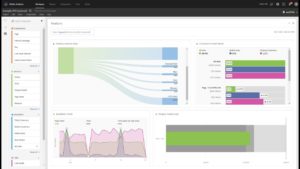
Source: Analysis Workspace Overview | Adobe Analytics
User-Centric Design
User experience is paramount for conversion rate optimization. Beyond just aesthetics, the user-centric design encompasses the overall usability, accessibility, and intuitiveness of your site. To boost conversion rates, it is imperative to ensure that your website not only captures attention but also guides users seamlessly toward desired actions.
To create a user-friendly interface, focus on intuitive navigation that intuitively directs visitors on a seamless journey through your site. Develop a clear and concise path to conversion, minimizing any unnecessary steps or distractions along the way. Furthermore, optimize the layout of your website to facilitate a smooth and engaging user journey. Reduce friction points, streamline processes, and implement responsive design principles so they adapt seamlessly across various devices. All these strategies will contribute significantly to enhancing the overall user experience.
A/B Testing
Experimentation is a cornerstone of CRO, providing valuable insights into user preferences and behaviors. This experimentation process involves comparing two or more versions of specific website elements to determine which resonates most effectively with your target audience. Beyond the surface level, A/B testing is an iterative and data-driven approach that enables you to continuously refine and optimize various aspects of your website.
Engaging in A/B testing empowers you to scrutinize diverse elements, including headlines, images, and call-to-action buttons. Then, by systematically altering these components and analyzing the resulting user interactions, you gain actionable data to inform strategic decisions. This iterative process is not only about identifying what works best but also about understanding the nuanced preferences of your audience. When A/B testing is integrated into your conversion rate optimization strategy, it becomes a dynamic tool for honing your website’s performance and aligns it more closely with the expectations and desires of your users.
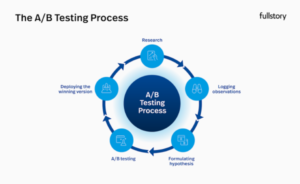
Source: FullStory
Mobile Optimization
With an increasing number of users accessing eCommerce sites via mobile devices, mobile optimization is not just a box to check off in the list of website features. In the contemporary digital landscape, it is non-negotiable for the success and competitiveness of your eCommerce site.
Responsive design lies at the core of effective mobile optimization. It involves crafting a website that seamlessly adapts to various screen sizes, resolutions, and orientations, providing users with a consistent and enjoyable experience across different devices. Beyond the surface-level adaptation, the user interface and functionality must be intuitively designed for touch-based navigation, recognizing the unique interactions associated with mobile devices.
Optimizing the mobile user experience goes beyond just responsive aesthetics; it involves optimizing loading times, streamlining navigation, and simplifying the checkout process to cater specifically to the constraints and preferences of mobile users. By doing so, you not only enhance user satisfaction but also increase the likelihood of conversion, as users are more likely to engage and transact on a site that seamlessly caters to their mobile needs.
Mobile optimization also plays a crucial role in positively influencing search engine rankings. Major search engines, including Google, prioritize mobile-friendly websites in their algorithms, recognizing the significance of catering to the mobile audience. As such, a well-optimized mobile site can contribute to higher visibility in search results, driving organic traffic and further solidifying your eCommerce platform’s digital presence.
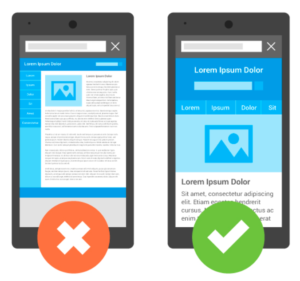
Source: BlueSquare
Site Speed Optimization
Site speed optimization is crucial for eCommerce success, as users demand instant gratification. The speed at which your online store loads can significantly influence user experience and conversion rates. In the fast-paced digital landscape, users demand instant access to information as well as swift transactions.
A slow-loading website can lead to high bounce rates, causing potential customers to abandon their shopping journey. On the contrary, a fast and responsive site enhances customer satisfaction, boosts engagement, and increases the likelihood of successful transactions.
Additionally, optimized site speed positively impacts search engine rankings, contributing to improved visibility and attracting more potential customers in the competitive eCommerce arena.
Optimize your site’s speed by compressing images, leveraging browser caching, and minimizing unnecessary scripts. Google’s Page Speed Insights can help identify areas for improvement.

Source: Simone Hearne
Optimized Product Pages
Product pages play a pivotal role in driving eCommerce conversions. It is imperative that they are meticulously curated via a multifaceted approach that goes beyond mere visual appeal. High-quality images are the cornerstone, providing potential customers with a detailed and captivating view of your products. Transparency in pricing information is equally crucial, fostering trust and eliminating potential barriers to purchase.
Moreover, the implementation of a clear and persuasive call-to-action (CTA) should not be underestimated in its potential impact on conversion rates. Crafting CTAs that are not only visually distinct but also resonate with your target audience’s desires can guide users seamlessly through the conversion funnel. A strategic alignment of these elements ensures that your product pages transcend mere display, transforming into interactive and persuasive platforms that drive optimal conversion outcomes.
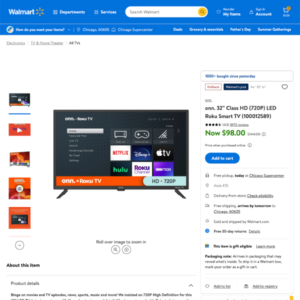
Source: Baymard
Streamlined Checkout Process
A lengthy or complicated checkout process can deter potential customers and introduce unnecessary friction at the critical point of transaction. Simplify and streamline the checkout process, reduce form fields, place the CTA above the fold, and offer guest checkout options. Additionally, display trust badges to instill confidence in your customers.
To counteract this, an eCommerce business can adopt several strategic measures:
- Reducing the number of form fields is a fundamental step that helps ensure users are not overwhelmed with information input requirements. Placing the call-to-action (CTA) prominently above the fold capitalizes on prime visual real estate, enhancing its prominence and encouraging immediate action.
- Displaying trust badges, such as secure payment icons or certifications, serves as a visual assurance of the safety and legitimacy of the transaction process. These trust indicators can alleviate concerns related to online security and data privacy and foster a sense among potential customers that your business is trustworthy.
- Offering guest checkout options is another valuable tactic. This allows users to complete their purchases without the need for a lengthy account creation process, catering to those seeking a swift and hassle-free transaction. Moreover, it can help instill critical confidence in customers.
A comprehensive approach that incorporates these streamlined checkout elements facilitates efficient transactions and contributes significantly to a positive user experience. It also bolsters conversio nrates and customer satisfaction.

Source: 2checkout case study
Personalization
Personalization is a powerful strategy in the realm of eCommerce, revolutionizing the way businesses interact with their online audience. Going beyond a one-size-fits-all approach, it involves tailoring website content to align with individual user behavior, preferences, and demographics.
Targeted product recommendations emerge as a cornerstone of personalized content delivery. By analyzing a user’s browsing history, purchase patterns, and interactions with the site, algorithms can intelligently suggest products that align with their interests and needs. This not only enhances the user’s shopping experience but also increases the likelihood of successful conversions.
Dynamic content takes personalization a step further by presenting users with website elements that adapt in real time based on their behavior. This can include personalized banners, offers, or even entire sections of a website that dynamically change to cater to the unique preferences of each visitor. This dynamic adaptation creates an immersive and tailored journey that fosters a deeper connection between the user and the brand.
Personalized email campaigns also play a pivotal role in extending the personalization strategy beyond the website. Leveraging user data, businesses can craft email content that speaks directly to the recipient’s interests, previous interactions, and purchase history. This increases the communication’s relevance and enhances the chances of email engagement and conversion.
The cumulative effect of these personalized strategies is the creation of a more engaging and relevant user experience. Users feel seen and understood, which fosters a sense of loyalty and connection to the brand.
Utilize Social Proof
Customer reviews, testimonials, and user-generated content are powerful tools for building trust and credibility. Displaying positive feedback on product pages can influence potential customers and increase their confidence in making a purchase.
Consider incorporating a ratings and reviews system on your product pages and adding concise graphics to the checkout page (product performance stats, stamps, awards, accreditations, star reviews, or other trust logos that highlight the quality and reliability of the product).

Source: 2Checkout (now Verifone)
Implement Urgency and Scarcity
Create a sense of urgency and scarcity as a strategy to prompt immediate action. Limited-time offers, countdown timers, and low-stock notifications can drive conversions by encouraging users to make decisions quickly.
You can also capitalize on exit-intent popups to re-engage users who are about to leave your site. Offer discounts, exclusive deals, or compelling content to entice them to stay or complete a purchase. Timing is crucial; trigger popups with countdown timers when users show signs of abandonment.
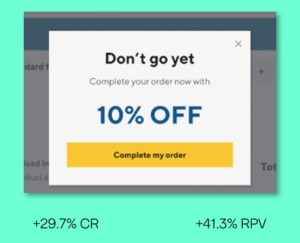
Source: 2Checkout (now Verifone)
Conclusion
Mastering conversion rate optimization is an ongoing process that requires a combination of strategic planning, continuous testing, and a commitment to delivering an exceptional user experience. By implementing the CRO tactics and strategies discussed here, eCommerce businesses can unlock their full potential and achieve sustained growth in our ever-evolving digital landscape.